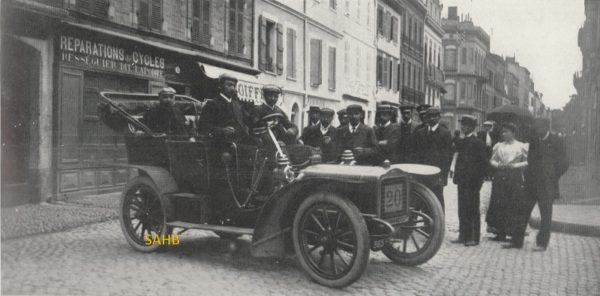
Our Snapshot this week is of a French competition car. We have to admit that we had never heard of the make until finding this image in a 1905 French sporting magazine – but from then on our researches turned up quite a lot of information.
Automobiles G. Brouhot & Cie was a French manufacturer of automobiles and engines. In the 1890s, Charles Brouhot founded a company in Vierzon to produce agricultural equipment. He formed his independent automobile company in 1898 and made cars until 1911. His first model had a rear-mounted horizontal two-cylinder engine. By 1903 there was a two-cylinder 10 CV, and by the date of our Snapshot the company made a wide range of four-cylinder models from 10 CV to 60 CV.
Brouhot is best known for its participation in the 1903 Paris to Madrid race with a 40 CV car of 8,013 cc. The car crashed near Angoulême, killing the mechanic and two spectators. According to most accounts this led Brouhot to give up motor sport for ever.
But this is not so. Our Snapshot shows a Brouhot, driven by Belleville, before the start of the Coupe des Pyrénées – a tour for passenger cars organised in 1905 by the newspaper La Dépêche du Midi and the magazine La Vie au Grand Air with the aim of promoting the Pyrénées region. The tour started and finished at Toulouse between August 20 and 27 1905 and passed through Carcassonne, Narbonne, Perpignan, Luchon, Cauterets, Pau and Bayonne.
This Brouhot was far from being a lone entry by the company. There is another photograph taken in the same location that shows four Brouhot cars of varying sizes and includes M Belleville’s machine No. 20. The car No. 88 alongside it appears much larger and is therefore more likely to be a 40 CV or 60 CV machine – and the caption to a photograph of No. 20 in the post-event report in the September 2 1905 issue of L’Illustration confirms that M Bellevile’s car is a 15 CV.
Despite its limited size Brouhot No. 20 was successful. The magazine Le Chauffeur of September 20 1905 gives the following results:
1st: Sorel (De Dietrich) 5,356 Points
2nd: Belleville (Brouhot) 5,242 Points
3rd: Didier (De Dion-Bouton) 5,038 Points.
And the other Brouhot cars were not far behind. After Bablot in a Berliet in 4th place, Brouhot cars driven by Richez, Feuillet and Maréchal came in 5th, 6th and 7th respectively.
Brouhot continued to manufacture its high-quality cars, direct rivals of De Dietrich and Delaunay-Belleville, until 1911 when the company found the competition from other makes too stiff and returned to its main agricultural equipment business.
There are some curious British footnotes. The Brouhot Motor Company of Great Britain advertised in 1904, and Brouhot sold its cars in the UK under the names Club and Smart. And the Elswick car, made in Newcastle-upon-Tyne, at one time used a 4-cylinder 20 hp Brouhot engine.







Leave a Comment